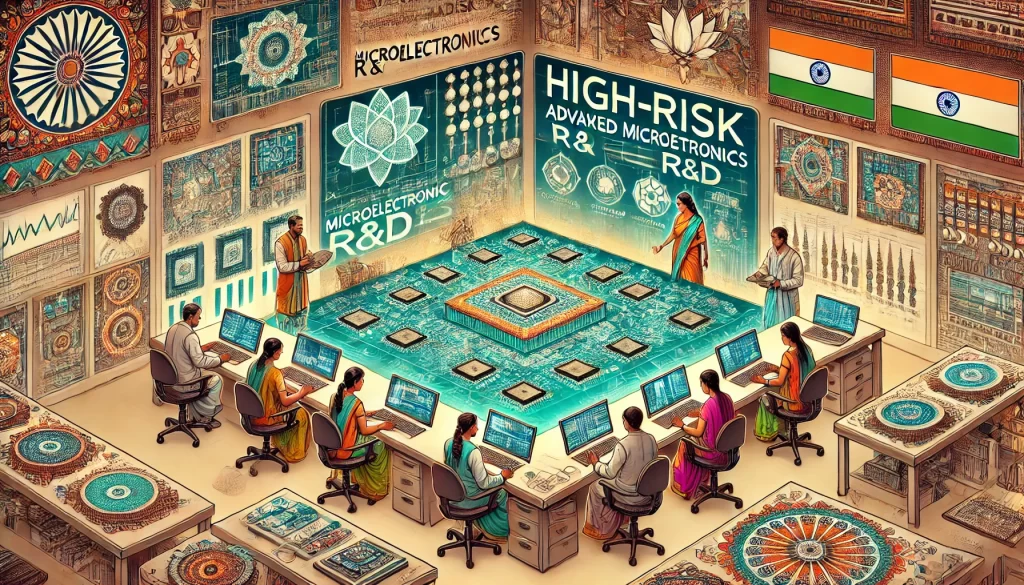AUTHOR : ISTELLA ISSO
Introduction
India is rapidly evolving into a significant hub for cutting-edge technological advancements. Among these, high-risk advanced microelectronics research and development (R&D) stand out as a field with immense potential. Microelectronics powers modern technology, driving innovations in smartphones, computers, IoT devices, and AI. However, the journey to breakthrough innovations in microelectronics is fraught with challenges and risks. This article delves into the importance of high-risk R&D in India’s microelectronics sector and how it is shaping the future of technology.
The Current State of Microelectronics in India

India has a strong electronics legacy, but high-end microelectronics progress has been limited by reliance on imports and lack of domestic manufacturing. Today, however, the country is positioned as a rising player in the global microelectronics market. With its growing expertise and ambitious initiatives, India is becoming increasingly self-reliant in producing advanced semiconductor devices and systems.
Challenges in High-Risk R&D for Microelectronics
High-risk R&D projects, especially in microelectronics, require massive investment in both time and resources. There are several challenges that researchers and companies face in pushing the boundaries of innovation:
- Technological Barriers: Microelectronics R&D demands access to cutting-edge technologies and fabrication facilities, which are expensive and complex.
- Financial Constraints: Large-scale R&D in high-risk areas often demands long-term investment with uncertain returns. Securing funding for such projects is a significant challenge.
- Infrastructure and Skill Gaps: Advanced Microelectronics R&D[1] Despite progress, India still lacks advanced research infrastructure and skilled manpower in microelectronics, hindering innovation and advancements.
Key Players in India’s High-Risk Microelectronics R&D
The Indian government has recognized the importance of microelectronics R&D and is actively investing in high-risk research. Microelectronics Development[2] Several key players have emerged in this domain:
- Government initiatives like the National Policy on Electronics (NPE) and the Electronics Development Fund (EDF) aim to boost R&D, foster innovation, attract investments, and strengthen the electronics manufacturing ecosystem.
- Leading institutes like IIT and IISc are driving R&D and advancing microelectronics.
- Companies like Intel, Qualcomm, and Samsung are investing in Indian R&D and collaborating with local firms and universities to drive innovation and strengthen industry-academia partnerships.
Emerging Technologies in Microelectronics R&D
Several exciting emerging technologies are fueling advancements in high-tech microelectronics revolution[3]. India’s focus on these areas is beginning to yield promising results:
- Quantum Computing: This is one of the most revolutionary areas in microelectronics. Quantum processors could eventually surpass traditional silicon-based chips in performance, and, as a result, India is increasingly focusing on this field to stay competitive, foster innovation, and accelerate technological advancements.
- AI-Driven Advancements: Artificial intelligence is playing a crucial role in chip design, optimizing processes that were once painstakingly manual. AI algorithms can predict the performance of microelectronics more efficiently, paving the way for faster innovation.
- 3D Microelectronics: The ability to create multi-layered chips and devices not only promises to improve performance but also helps reduce space, Innovations for High Performance Microelectronics[4] enhance energy efficiency, and open up new possibilities for compact and powerful electronic systems. 3D stacking is a key area for future microelectronics.

International Collaborations in High-Risk R&D
India’s role in global microelectronics innovation is growing as it becomes an attractive partner for international collaborations. Microelectronics Components and Functions[5] Global tech giants, like IBM and TSMC, are keen on working with Indian researchers to develop the next generation of microchips and technologies. These partnerships help India gain access to advanced technologies, creating a platform for knowledge exchange.
Government Support for High-Risk R&D in Microelectronics
The Indian government has made strategic investments to support high-risk R&D in microelectronics. Several funding schemes and policy frameworks encourage innovation, offering grants and tax incentives to private and public research bodies. Additionally, public-private partnerships play a vital role in advancing microelectronics R&D, fostering collaboration between government agencies and tech companies.
Investment Landscape in Advanced Microelectronics
Investment in microelectronics R&D is rapidly increasing, with both government and private entities playing a role. The Indian government’s focus on creating semiconductor manufacturing ecosystems and attracting global investments is critical in shaping the future of the industry. Moreover, venture capital is not only flowing into startups that are working on advanced microelectronics solutions but is also driving innovation, fostering entrepreneurship, and accelerating the commercialization of cutting-edge technologies.
The Impact of High-Risk R&D on India’s Economy
High-risk microelectronics R&D is expected to bring substantial economic benefits to India:
- Job Creation: Advanced microelectronics technologies will require highly skilled professionals, leading to an increase in jobs and fostering talent development in the country.
- Boosting Digital Economy: The rapid expansion of the digital economy in India will be supported by advancements in microelectronics, enabling more efficient and faster digital systems.
- The push for high-risk R&D ensures India’s technological independence, reducing reliance on imports and enhancing national security.
Technological and Economic Risks in High-Risk R&D
The inherent risks associated with high-risk R&D in microelectronics include high costs, long timelines, and uncertain outcomes. Despite challenges, India has developed risk mitigation strategies through increased collaboration, government initiatives, and a growing ecosystem of research-focused startups.
Case Studies of Successful High-Risk R&D in India
India has had several notable successes in high-risk R&D in microelectronics. For instance, the Indian Space Research Organisation (ISRO) has not only successfully developed microelectronics technologies for space exploration but has also achieved significant breakthroughs in semiconductor manufacturing, thereby showcasing India’s growing capabilities and potential in advanced technologies.

The Role of Universities and Research Institutions
Indian universities and research institutions are key players in the high-risk R&D landscape. Through industry collaborations, they provide research, nurture talent, and strengthen the workforce to foster long-term innovation. Universities like IITs are home to some of the brightest minds pushing the envelope in microelectronics.
The Future of High-Risk Microelectronics R&D in India
Looking ahead, India’s future in high-risk microelectronics R&D is promising. The country is expected to focus on next-generation technologies like quantum computing, AI chips, and highly efficient semiconductor manufacturing processes. As the industry matures, India will likely become a global leader in microelectronics innovation.
Conclusion
High-risk advanced microelectronics R&D in India holds significant promise. With the backing of government policies, international collaborations, and a growing investment landscape, the country is positioning itself as a future leader in microelectronics. By embracing these challenges, India can achieve technological self-reliance, enhance its economic growth, and contribute to the global tech ecosystem.
FAQs
- What is high-risk microelectronics R&D? High-risk microelectronics R&D refers to research projects that involve advanced technologies, with uncertain outcomes and high financial costs, aiming to achieve breakthroughs in semiconductor and chip design.
- Why is microelectronics R&D important for India? Microelectronics R&D is crucial for India’s technological advancement, helping the country become self-reliant in key areas like semiconductors, which are essential for modern technologies.
- How does government support high-risk microelectronics R&D in India? The Indian government supports high-risk microelectronics R&D through funding programs, policy frameworks, and public-private partnerships aimed at encouraging innovation.
- What are the emerging technologies in microelectronics? Some emerging technologies in microelectronics include quantum computing, AI-driven chip design, and 3D microelectronics.
- What are the economic benefits of high-risk R&D in microelectronics? High-risk R&D can boost India’s economy by creating jobs, fostering digital transformation, and ensuring technological self-reliance.

